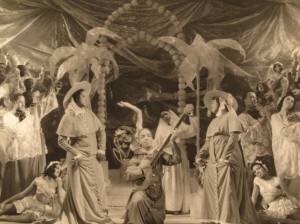by Aileen D. Bastos
Arthur Everett “Chick” Austin Jr., director of the Wadsworth Atheneum Museum of Art in Hartford from 1927 to 1944 brought never-seen-before art, theater, and culture to the state. Austin, a visionary in the art world, added works to the museum’s collection by established masters as well as contemporary artists. He exhibited the first retrospective of Pablo Picasso’s work, brought the Ballets Russes to Hartford, and hosted the theatrical performance of Gertrude Stein and Virgil Thomson’s Four Saints in Three Acts, featuring the first entirely black cast in an opera. In addition to the modern art of his time, including works by Dali, Mondrian, and Picasso, Austin specialized in art of the Renaissance and Baroque periods. Notably, in 1943, he acquired Saint Francis of Assisi in Ecstasy for the Atheneum—the first Michelangelo Merisi da Caravaggio purchased by an American museum.

“Four Saints in Three Acts,” an opera by Gertrude Stein. The first public performance was held February, 1934 at the Wadsworth, Hartford – Wadsworth Atheneum Museum of Art
Chick Austin was born in Brookline, Massachusetts, on December 18, 1900, to Laura Etiner and Arthur Everett Austin, a surgeon. Austin attended Harvard University, graduating six years after matriculation. The first course in which Austin impressed a professor was an art history class focusing on the Middles Ages, Renaissance, and Modernism. Austin continued to astound the Harvard faculty, whose classes he actually attended, and eventually fell under the guidance of Edward Waldo Forbes who encouraged Austin to travel to Italy to learn the art of Renaissance painting techniques. Forbes, a distinguished member of the Harvard faculty, member of the Board of Trustees at the Museum of Fine Arts in Boston, and Director of the Fogg Museum, also invited Austin to join him to work at the Fogg and eventually recommended Austin to the Board of Trustees of the Wadsworth Atheneum to become director there in 1927. At the same time, Austin joined the faculty of Trinity College and founded the fine arts program, teaching art history to undergraduates.
Austin married Helen Goodwin, daughter of Reverend James and Frances Brown Goodwin, in 1929. The wedding took place in Paris, France, where Austin purchased works for the museum. In the summer of 1931, Austin conceived of the exhibition Newer Super-Realism and requested loans of Surrealist works from collectors and galleries in Hartford, New York, Chicago, and Paris. The Newer Super-Realism exhibition was the first of its kind in the United States. Previously, only shows for individual Surrealist artists had been held, but this one brought them together. The show promoted artists like Dalí, Joan Miró, Pierre Roy, and Max Ernst and surveyed the imaginative, dream-like situations combined with realistic objects that characterize Surrealism.

Chick Austin at the opening of the surrealist exhibition, during a live broadcast on WTIC. Austin doctored the picture, adding Helen Austin to one of the De Chirico figures (upper left) – Wadsworth Atheneum Museum of Art
A Well-rounded Austin Transforms the Wadsworth
At the time, few museums had the luxury of staff or time to dedicate to the various museum departments that have become vital. Austin was not only director, he was a curator, designer, preparator, and educator as well. Austin sought pictures that expressed Surrealism as the latest development in the art world and would advance the awareness of Atheneum visitors. Newer Super-Realism exemplified Austin’s progressive nature and gave Hartford credence as a center for art and culture. It was one of Austin’s many accomplishments to keep the community abreast of what he considered important contemporary advances in art, theater, film, and dance. It was his goal to modernize Hartford, and through his efforts, Austin transformed Hartford into an artistic and cultural destination.
Chick Austin’s career at the Wadsworth Atheneum is characterized by dichotomy. His love for both the old and the new existed in all aspects of his life. Professionally, Austin collected art from the Renaissance as often as he did from the contemporary Surrealist and Modernist movements. Personally, he constructed his home on Scarborough Street in Hartford to reflect a centuries-old Italian villa on the exterior and modern Bauhaus design inside. After resigning from the Wadsworth Atheneum in December of 1944, Austin went on to the John and Mable Ringling Museum of Art in Sarasota, Florida. Forbes, who had provided the opportunity for Austin to become director at the Wadsworth Atheneum, was contacted by Governor Millard Caldwell and asked for assistance in recruiting the first director of the Ringling Museum. The museum had the most extensive collection of Baroque paintings in the country, and Forbes naturally selected Austin. Austin remained a fixture in the art world until he died from lung cancer on March 29, 1957.
Aileen D. Bastos, a former staff member of the Wadsworth Atheneum Museum of Art, holds a BA in museum studies and art history from Regis College in Massachusetts and is pursuing her MA in public history at Central Connecticut State University.









